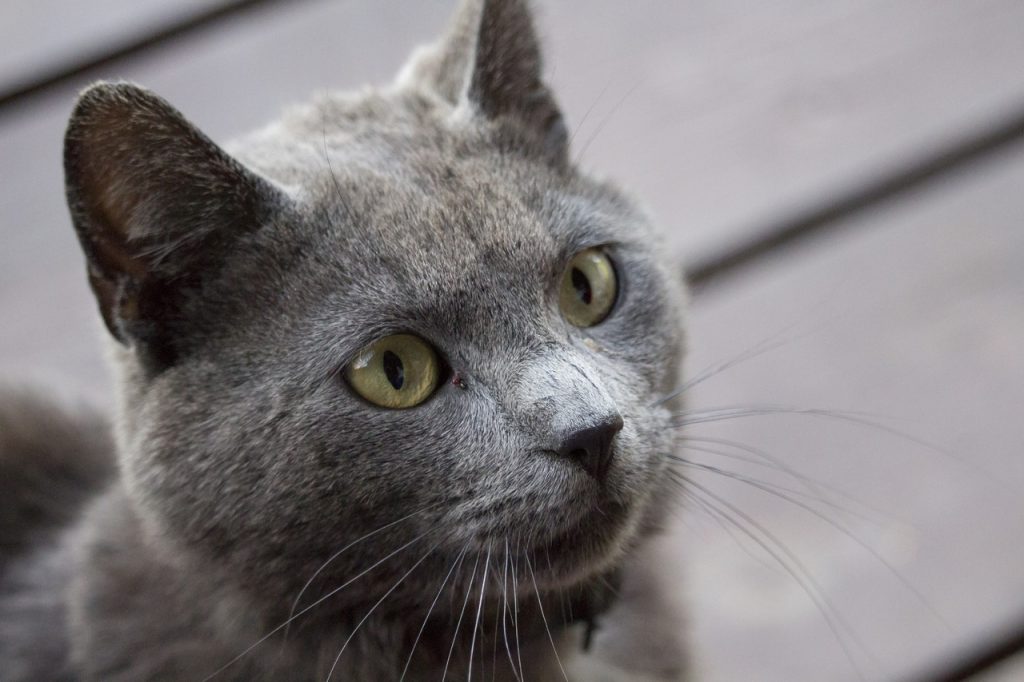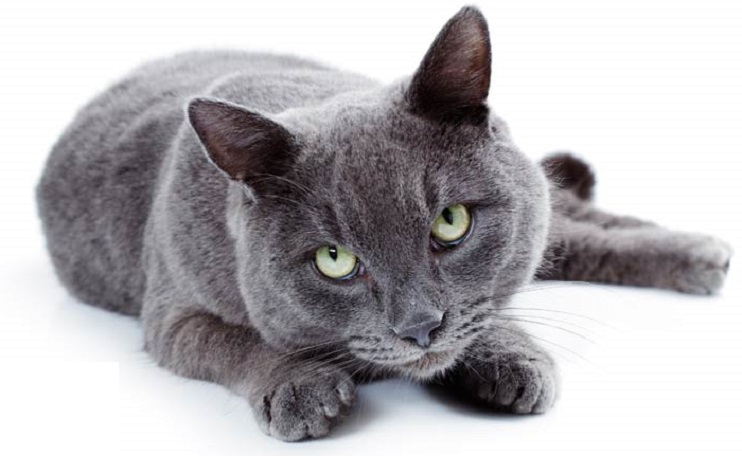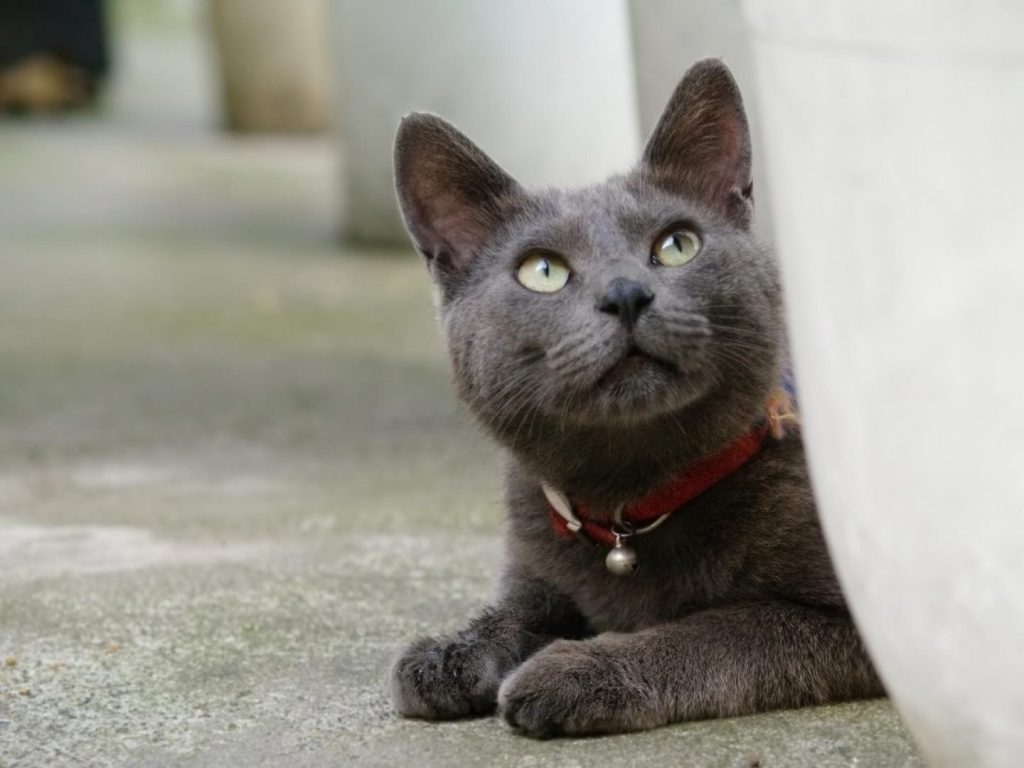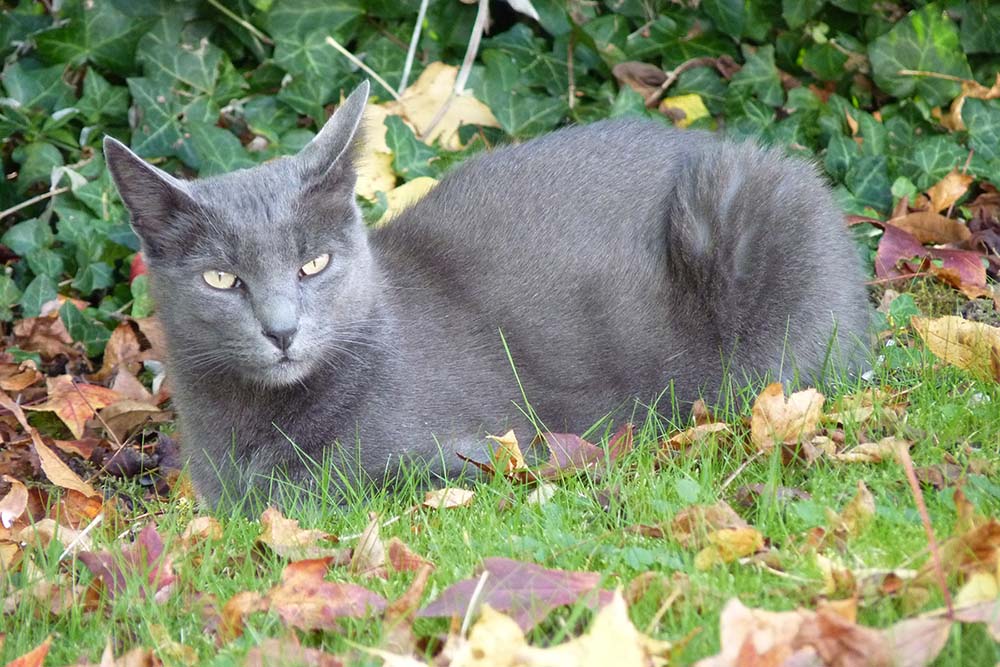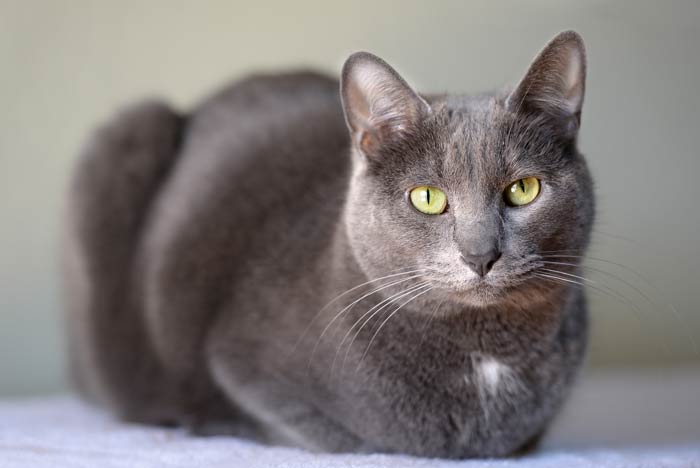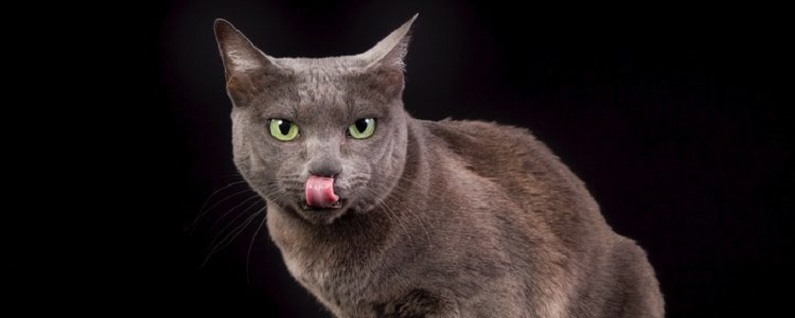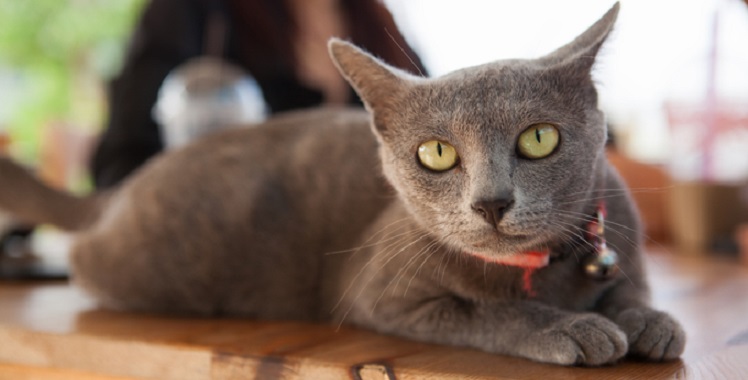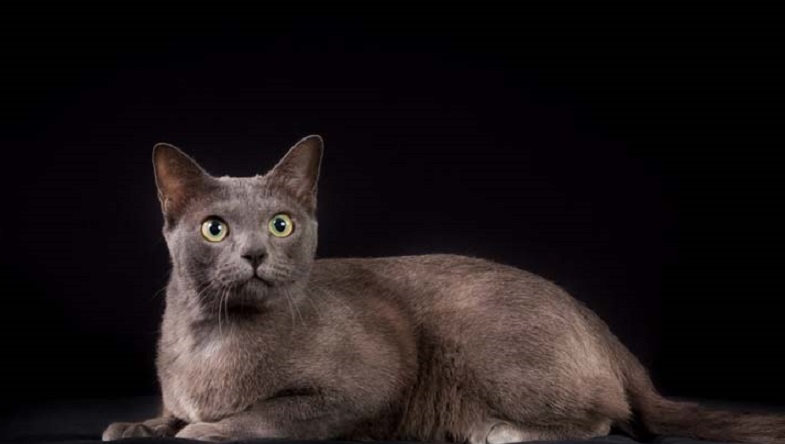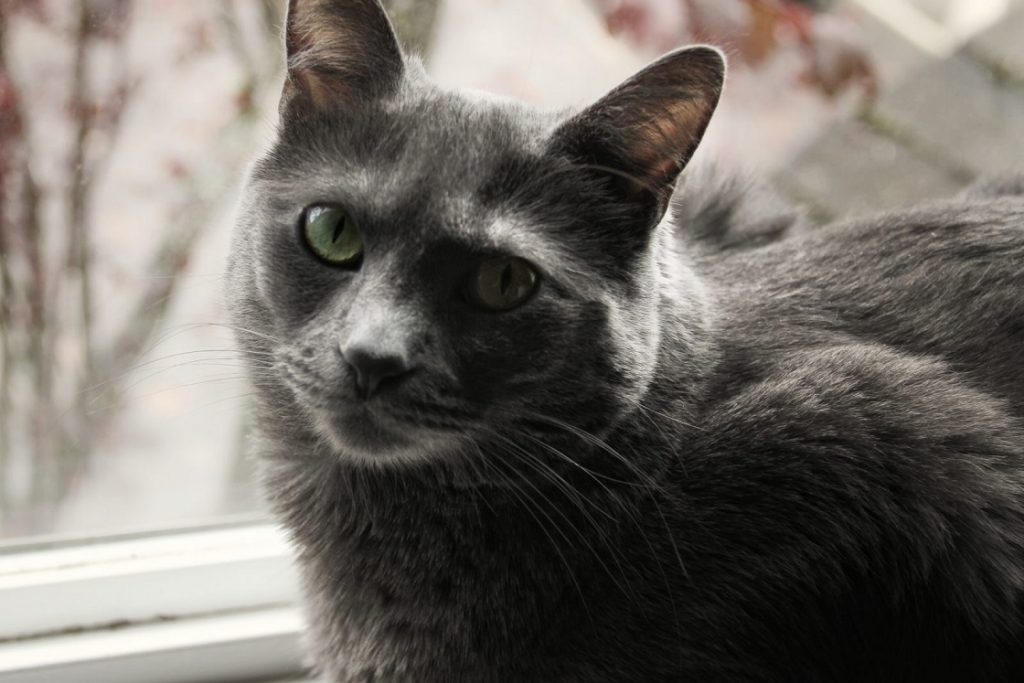
Korat Cat, Your New Pet
Beautiful as intelligent, the Korat is undoubtedly one of the feline specimens that can attract the most attention to the naked eye. Their bluish-gray tone, combined with greenish-yellow eyes, makes it special to see them. Accordingly, their strong personality stands out when you adopt them to be your pet.
This kitten comes from Thailand and has an interesting history since its presence dates back to old times. Records indicate its description and beauty since the 14th century, which makes it one of the oldest breeds according to historical documents.
Furthermore, their color is similar to the tones displayed on rainy seasons. This feature is very flattering since it reminds of the end of the drought and the reproduction of harvests. Consequently, in a short time, they earned the reputation of being kittens that attracted good fortune.
Thanks to this, the entire community started using them in rituals and appreciating them more. Still known as lucky cats, they have a point in their favor with those who are fascinated by these matters.
Their exportation started late, so they became known in America and Europe only a few years ago. However, this has not limited them as they still have fans, FIFe has already recognized them, and they have participated in feline exhibits.
Additionally, their physical traits make them particularly attractive. Their features combine the forehead, wide cheekbones, and nose with a small mouth. This well-defined heart figure is associated with fertility and success in marriages, which is why they are presents for newlyweds as an amulet of prosperity.
Their body is muscular, and they are medium-to-small felines, well developed, with nice proportions. They are agile and fast, with an advanced nose that makes them good hunters. They are also good at climbing and can hike or jump with ease.
The color of their fur is the most characteristic trait in their bodies. Their gray-blue tone distributes evenly throughout their figure, without presenting spots or prints. Even so, you can see how each hair ends in a silvery shine that stands out even more in the areas where the fur is short, as in their legs.
Their temperament is truly enjoyable, as they are hugely close to their owners and are quite faithful to them. They need their love and care, and they will not hesitate for a second to express it. The Korat is a talkative kitten, that is, by either meowing or with their expressions, they will easily show that they want.
These cats are extremely sensitive, so you have to be careful with your behavior. They do not tolerate loud or abrupt sounds, becoming scared or disturbed quickly. They prefer quiet homes where they can be silent and quiet, but they can adapt to hurried homes and can be more outgoing.
They are ideal for city life as they do not need much space, and they prefer to be inside and do not try to visit any neighbor. Likewise, they are not very friendly with strangers or children, so they need a socialization process in which you teach them how to live with them.
Korat cat’s care is basic, hence why they do not require any special treatment besides those that any feline pet should receive. A brush in their fur to help keep it healthy and strong, their regular baths, and caring for their oral hygiene. Treating their nails and cleaning their ears will also keep them in good condition for a long time.
These felines feed just like any other domestic cat. They will eat croquettes, canned food, or homemade food, and they need a little variety on the menu because they can get bored with their taste or texture. They have to drink a lot of water, and they are a bit fussy about cleaning their utensils. They are carnivorous and require protein to grow in a good way, but they need to have a balanced diet.
In general, they are healthy kittens. Nevertheless, some of them may be born with a genetic fault. This fault causes them to suffer from a disease that affects them neurologically and can end their lives before they reach the first year. Those who do not get it are healthy enough and require the proper attention that all cats need. This attention includes their vaccines, vitamins, good nutrition, and daily exercise..
History and Origin
The origin of the Korat is in the province of Thailand, former Siam, known as Cao Nguyen Khorat. Although, it is not certain what crossing gave birth to this breed. Fortunately, the age of its ancestors indicates that it is one of the few species in which man has not intervened.
Many of the breeds we know today have had the help of men in their crossings, sometimes being a misfortune for the felines. They would put their hands in crossing by adding cats that would help them find the qualities they desired. This influence was either to train domestic kittens or cats specialists in rodent hunting, obtaining the results in their favor.
In any case, this always leaves a mark, sometimes positive and sometimes not, in the evolution of the breeds. The Korat is the palpable demonstration that, many times, nature can spontaneously create species with very characteristic and special features. All of this, while keeping them strong.
The Korat’s birth is not registered, even if documents portrayed its presence in the 14th century. In this century, “The book of poems of cats” by Smud Khoi speaks with dedication and appreciation of a cat with its physical features. This poem may even be the first time that the breed is standardized.
On the other hand, their beautiful bluish color and their heart-shaped face, in addition to their sweetness, made them very dear in their hometown. They have associated with good fortune thanks to their fur that resembles the sky when the rain approaches. This rain helped in the crops, and thus the breed became an amulet for rituals that would stop the drought.
This association meant that it would receive the name Si-sawat, which translates to “lucky charm” but later changed to «fortune cat», deriving from «good luck cat». Moreover, in some areas, some people call it “color of prosperity”. However, in our continent, people know it as Korat, with the pronunciation being Ko-raht, alluding to its hometown.
Some families in Thailand have continued the ancient tradition of giving them to newly married couples as a valuable present that brings prosperity and fertility.
Despite its antiquity, the Korat is not so popular in the rest of the world. Some believe that people mistake them for other silver-blue cats that appeared in other countries. Therefore, their extension outside Thailand did not receive recognition until much after.
In the middle ages, the extermination of various cat breeds in Europe caused the disappearance of many felines. Due to false ideas that associated felines with evil entities, people slaughtered these kittens. They used bonfires and other means because people were afraid of them and did not want to distribute this breed around the world. In Thailand, communities avoided sending these cats to places where superstitious men did not appreciate them. Years later, exportation increased vastly, and they received much acceptance.
Its appearance in the American continent happened in 1959, a long time later considering that its birth dates from 1350. They arrived in the United States as a gift to the American ambassador of Thailand, receiving immediate acceptation from fans and forming breeding houses.
Likewise, they arrive in Europe formally a decade later and begin its entrance in Germany. By this time, their popularity began to emerge and managed to get the recognition of various important associations in feline matters such as the CFA in 1969 and FIFe in 1972. Then, these associations approved their standard record.
Once they got their acceptation and registration, they participated in various feline exhibitions. Their first participation was in the 1984 London exhibition, where a young man called Mr. Spearman led one of them, and the breed captivated more admirers.
Still, you cannot find them in several countries, but little by little, they have been gaining ground and are becoming the favorites of many families. In addition to their beauty, their association with good fortune and their exotic fur attracts people’s attention. They are also very sociable and loving kittens capable of becoming excellent pets.
Breed Characteristics
The Korat Cat is a singularly elegant animal. They are small-to-medium-sized, which stands out for the exuberance in the color of their fur as not a lot of breeds possess their gray-blue tone. Additionally, their faces and features are well defined and beautiful.
Their behavior matches the shape of their body, which shows a lot of flexibility and strength. They are agile and quite active, can run quickly and jump, and are good climbers. However, they prefer home interiors where they adapt and become delicate and sly.
FIFe classifies them as category III, that is, among shorthaired and Somali cats. Alongside the Russian Blue, Chartreux, and British Shorthair, they represent the most popular cats with this fur color.
This breed does not present much difference between males and females besides the characteristics of each sex. Females are usually slightly smaller and more refined, but you can still confuse both of them due to the short gap in their size, which standardizes as:
The male’s measure is between 20 cm and 35 cm high.
The females reach between 20 cm and 30 cm high.
Both genders should weigh between 3 kilos to 4 or 4.5 kilos. It is convenient to evaluate them constantly, so they do not exceed 10% of this weight. These examinations will prevent them from suffering from overweight, especially because they are pets that love staying at home.
These cats have an ideal length, not too long or too short. They are quite muscular, both males and females. Even so, females tend to be more delicate, elegant, and slender, but quite strong and flexible.
The head of the Korat has a flat and wide forehead, of strong and well-developed cheekbones that get sharper considerably from the snout to the mouth. This trait gives their face the shape of a heart while being soft and well proportioned.
The nose is very small, with a poorly defined stop. It is quite delicate with a dark blue or dark gray tone that does not depart much from the tone of the fur. This color makes it barely noticeable, with the nostrils being medium, not showing from the front, and with a rounded bottom tip.
Their eyes are quite large in comparison to their faces. They are round, with a tendency to the almond shape, located following the upper contour of the snout. The color is yellowish-green but also come in amber tones. Not all kittens develop the color soon, getting the tone at almost two years of age. Their pupils are vertical.
The eye’s look is extremely sweet and intelligent. They symbolize them being highly attentive and can be expressive.
Their ears are located in the upper part of the skull and are somewhat large without being disproportionate. They are triangular with a wide base and round tip. Short and soft hair cover them, and the one that protects the pavilion is long and of the same silver-gray tone of fur.
These kittens have highly thick fur, and it feels tight due to the large amount of hair they have. The length of the hair can be short or medium, depending on the environment and the inheritance of their parents. The texture is fine, being quite soft to the touch and bright, which can help to deduce the health status of the animal. If it is opaque or weak, they are likely to be suffering from some disease or poor feeding.
One of the aspects that distinguish them is the silver-gray blue tone of their fur, being solid without any stain or print. Nonetheless, the tip of the hair becomes more silver than the base. Their legs and snout may look brighter in their short hair, and the silver color prevails.
The Korat cat’s tail is neither long nor short, as it has a length quite proportional to the size and complexion of its body. It has a round section, wider at the base than at the tip, but it has a round end. They usually use it to show their mood, activity level, and desire to play or eat.
The movement of these cats is fluid and elegant. Their abilities give them the capacity to be excellent runners and hunters, and they can jump good heights. They stand out thanks to their preference to ride on the shoulders of their masters. Finally, the shape of their legs and the shape of their muscles make them good climbers.
Behavior and Personality
The personality of the Korat is remarkably unique, they are pets that adapt easily to the human environment, but they demonstrate their preferences.
With their masters, they are adorable, loving, faithful, and sweet. They prefer to be in their company than with any other, usually forming a stronger affective bond with them. They associate the person who feeds them with a figure of protection or care, and with whom they feel safe.
However, this is no reason to put aside the rest of their human families with whom they will also show much affection and acceptance.
This fact makes it not very practical to leave them alone at home since they always need to be in the company of their family. If they spend a lot of time alone, they can develop nervous behaviors. These include breaking furniture, defecating outside the litter box, scratching, cleaning themselves excessively, among other things. It is advisable to teach them from kittens to remain in their stroller basket or inside the car.
Their behavior adapts to the time and place. If they are in the garden or playing, they become active, agile, and attentive. They are good at climbing, running, jumping, and have a lot of energy. If they are at home, contrarily, they can be very serene.
Yet, their way of being at home is also closely associated with the way humans behave. For instance, if calm and quiet families adopt them, the Korat will be almost invisible, silent, sly, and will play harmoniously but always remain calm. On the other hand, if families that are a bit more active adopt them, they will also act accordingly.
Their meow is immensely pleasant and even melodious. They are one of the most talkative breeds as they demonstrate everything they feel. Many other feline breeds are more introverted, but the Korat is not. They demonstrate with their voice, as with their expressions, everything they feel or want, so it is extremely easy to understand.
For example, these kittens, in addition to meowing when they are hungry, can take a little more action in case their owner ignores them. They can roll up on their ankles or climb on their shoulders and give them soft taps on the neck or face with their legs, which is an indisputable sign of their desire to eat.
Likewise, they are tremendously sensitive, both with the way their owners treat them as well as with their growth in their surroundings. Their owners must take the precaution of not making them feel bad or of shouting or threatening them. This behavior will deeply hurt their feelings and can cause depressive states.
In this sense, the Korat demonstrates when they do not feel well. They startle, get scared or worried, and they dislike sudden noises, shouting, fights, exaggerated volume, or any intense variation of their environment or routine.
On the other hand, kittens must start to socialize when they arrive at home. Granting that they are very sweet with their family, their level of hypersensitivity makes them intolerant to children. Children could be abrupt with them due to their learning process with pets. This negative interaction will cause the feline to respond in a bad way. It is preferable to educate them on how to behave with children since kittens.
At this stage of socialization, you should try to put the little Korat in the hands of their human family. Following the veterinarian’s instructions, they have to pet them as much as they can, as well as playing with them and including them in family walks.
This way, the kitten will assume that this lifestyle is natural and will shape its behavior to human contact. Nonetheless, you should also take into account that the specimens of this breed are also not very likely to accept strangers. They get suspicious of these people and would rather ignore them, which is why it is likely that you will have to teach them how to tolerate strangers.
As a general recommendation, you should know that the majority of felines, no matter how social or adapted to the human environment they are, require a certain degree of respect. Preferably, in some of their special routines, such as their moment of rest or relaxation. They usually go to their basket to sleep or just to be alone for a while, and it is essential that they feel that you are giving them space.
In summary, the Korat is a singularly sweet, intelligent pet, which their owner must entertain by playing and should take an active part too. They are sensitive, talkative, and expressive. They require a stage of socialization so they can adapt to being near children or sharing with strangers. Lastly, they can live very well with the elderly and will adapt to the lifestyle of their adoptive family.
General Care
The Korat is undoubtedly one of the most appreciated pets in the feline world. Besides their adorable behavior and closeness to their owners, their maintenance is rather simple and does not require more than the usual for each feline.
Furthermore, these kittens are docile and love when you spoil them. Associating their cleaning routine with the idea of their master petting them and receiving compliments, as well as rewards, is the best strategy so they can accept this care.
They are kittens that prefer indoors. Even though they are active, they rarely try to escape through the window or door to play in the garden. They favor playing with their masters at home, which contributes to keeping them clean. Cats have the habit of grooming themselves by slipping their tongue through their bodies.
On the other hand, you should keep in mind that, although they are docile pets, they do not like getting soaked. Consequently, bathing them is not as easy as it seems, and you must be extremely patient. They will need greater sweetness, tolerance, and discipline from your part.
In addition to this, you should consider their extreme sensitivity to loud noises or altered behaviors when practicing any of these routines.
Grooming
Due to the peculiarities of their fur, the most advisable thing is that you brush the Korat at least twice a week. Its texture makes it very difficult to expel the hair that is dying and tends to remain accumulated in the new hair.
Although experts could classify them as hypoallergenic due to this little expulsion, it is always important to keep a watch on their soft fur. Try to keep it tidy and lustrous, and continue to brush them so you can remove the dirt that your pet has gotten during the day.
For this routine, there is a wide variety of comb types on the market, depending on your cat’s needs. As for the Korat, you can use almost all of them.
Among these, the card brush is the most common and helps to make a regular brushing. Still, there are other more studied such as the furminator, which is mainly used for shredding seasons and holds dead hair. The massager, which comes as a glove, more than combing, helps to activate the circulation in the skin of your kitten. Besides, you can also use dewormers at the time they require it.
Bathing the Korat
This aspect presents a little more complications. Luckily, your kitten can very well accept it as long as you carry it out with a precise routine that you teach them as soon as possible. As it happens with socialization, the Korat will assume that these customs are a natural part of its life as long as you teach them early.
Additionally, the highly developed smell of the kittens of this breed and their skin sensitivity means that they must use products specially designed for felines. They must not contain additional scents and should have the ideal softness so as not to disturb their fur.
For the rest, you should have the same considerations as for any other feline. Firstly, look for a comfortable space that does not have air streams that can affect the health of your cat. It should have small chances of escaping and must be clean, and placing it at table height can be very helpful.
You should also ensure that the water is clean and has a good temperature, neither too cold nor too hot. Likewise, you should have everything at hand and start wetting your cat, without touching their ears or face.
Then proceed to apply the shampoo and scrub it well. Wet it again after that, but this time with enough water and many times. Remember that these cats tend to slit their tongue through their bodies. For this reason, it is harmful that they ingest chemical remains while doing so. It is unsafe even if the packaging says that the products are safe for it. Therefore, it is prudent to make sure you remove the soap completely by wetting it many times.
Lastly, dry it with a towel and dryer at room temperature, comb it, and go. Leave it alone for a while and give it all the love they ask for in addition to its cookie reward.
Oral Hygiene
The mouth of your cat is always a priority in their maintenance since most of the food they eat tend to be moist and stick to their small teeth. This food can cause stones that then lead to missing teeth or halitosis. It is important to take care of their hygiene either by traditional means or with special powders in their croquettes or common food.
Diet and nutrition
The Korat, like most felines, requires their diet to have a meat intake. Their needs originated many centuries ago, and they have kept their necessity of nutrients that animal protein can provide.
Among these, amino acids, such as taurine, exist in smaller amounts in vegetables. They are essential both in the growth and maintenance of the Korat, as well as in the strengthening of their health. The liver is a good source along with eggs.
However, it is not wise to create an eating routine built around beef, chicken, or fish exclusively. It is always important to create a balance in their dishes, ensuring that they can also eat vegetables and carbohydrates. Cereals, on smaller amounts, must have a regulation since they cause the Korat to have difficulty in its digestion.
Feeding stages
The kittens of this breed go through several stages in their diet, due to their nutritional needs that vary frequently. As they mature, they need are other requirements, which would be good to consider if you want your pet to have a good life quality.
Primarily, the food in their first weeks of life, it should preferably come from their mother. She can provide in her milk everything that they gradually require, even water and vitamins. They should keep a breastfeeding diet until the month and a half of age.
If it is not possible to leave them with their mother for that long, you could use alternatives. You can buy milk formulas for kittens, and give it to them in a feeding bottle. Remember never giving them cow milk, as it is extremely harmful. Try to do everything in your hands to provide them a breastfeeding diet. This diet helps them both in their health and their mental and social development.
Once they mature and reach two months, you can start to include soft porridge. Food softened with water, not milk, also helps the kitten to chew easily, until its dentures have strengthened.
Then comes the longest stage, but it can be more varied in the Korat. The maintenance as an adult includes a complete and balanced menu, complying with the nutritional requirements. It can change due to the tastes of the kitten since they often get bored of their usual dishes or texture and even smells.
Once your Korat turns ten years old, you must regulate its diet according to the indications of the veterinarian. They begin to be elderly cats whose blood values begin to deteriorate and require a little more care.
On the other hand, other conditions can affect the quality or quantity of the food you provide. For instance, when the female is pregnant, she will need more food since she will feel hungrier. Another occasion is when your kitten is sick, as it may need different foods. The important thing is that they are well fed and that their weight does not exceed 10% of the accepted limit.
Croquettes
Croquettes are a good option when feeding your Korat. You should select it by looking for the one that contains good amounts of protein, as well as carbohydrates or vegetables, but that does not contain cereals. It is also possible to combine it with homemade food or to alternate it with preserves to keep the variety on the menu.
Moreover, it lasts long after the packaging is open. This food is different than canned foods that are water-based and break down quickly or from homemade food that also has less shelf life.
Homemade Food
Homemade food becomes, undoubtedly, the best option as long as you follow the appropriate recommendations for the feeding of your kitten. Keep in mind that it is ideal that they do not consume any type of seasoning or dressing. Fried foods or stews are also a big no-no. The amounts you provide must be consistent with the doses indicated by their veterinarian.
Likewise, you should also try to offer protein, whether meat, chicken, liver or fish, cooked or roasted, boneless, and never raw. Try not to abuse fish in any form, both tuna, and sardines. Complement the dishes with steamed or cooked vegetables that have a smooth texture and are easy to chew.
Treats
They are necessary, although you should provide them exclusively as a means of training reinforcing proper behaviors. They must understand that these are prizes and can come in several versions of products for kittens.
Health
The health of the Korat is regularly quite good, reaching approximately 16 years. Even so, studies have proved that they do suffer from a hereditary disease known as gangliosidosis. This genetic alteration affects their ability to metabolize some lipids or fats, which can accumulate and affect their cellular process.
Generally, cats with gangliosidosis show symptoms after four months. Although it is a typical disease of this breed, it does not appear in all specimens. Therefore, it is necessary that when they get it, you should take them to a veterinarian, who will do the respective tests.
Usually, this condition tends to disrupt the neurological system of kittens. It causes symptoms such as walking problems walk (ataxia or dysmetry), tremor, and involuntary eye movements. Other symptoms like enlarged liver, visual impairment, among others, can get worse over time and cause them to die between ten months to the first year of life.
On the other hand, the specimens that fortunately do not show this alteration can have a long and healthy life. Always take into account that they should enjoy proper care and good food. Like all domestic cats, they could be prone to viruses, fungi, or other conditions.
That is why you must follow the vaccination schedule the veterinarian indicates. They will establish the schedule according to the specifications of each country’s health system and those necessary for the breed. These vaccinations are mostly the ones that apply to any cat.
Its importance is vital since it helps the feline to create antibodies against certain viruses, preventing them from suffering or minimizing their effects. It is advisable to start the process once they reach the age of two months, which matches the time they stop breastfeeding.
It is important that the felines reach a certain degree of maturity in their organs and that their natural immunization process has begun before vaccination. Similarly, breastfeeding provides all the mother’s antibodies and keeps them protected for a while.
Depending on where they are, the schedule can be something similar to this:
-At a month and a half, the deworming process will start.
-At two months, apply leukemia and immunodeficiency examinations. Vaccination also starts by placing the first dose of trivalent (calicivirus, panleukopenia, and rhinotracheitis).
-At two and a half months, place the first dose of leukemia protection.
-At three months, place the trivalent reinforcement.
-At three and a half months, place the reinforcement of feline leukemia.
-At one year, place more reinforcements and rabies vaccine. Continue to place reinforcements annually.
On the other hand, many other diseases could affect Korat in the same way as it affects other cats. Relatively common conditions include overweight. Overweight tends to bother mainly the less active specimens and with less control of their feeding. It can bring negative consequences to the wellbeing of the pet.
They may also be prone to suffering from feline alopecia, that is, uncontrolled hair loss. This illness is nothing more than a way to express that something is going wrong in their health. These problems include allergies or nutritional problems, fleabites, or mites on their skin. Possibly, the Korat may have endocrine problems.
In any case, the most advisable thing when seeing baldness spaces is to go to the veterinarian. They will do the relevant tests and will prescribe topical creams, aimed at eliminating the causes of this illness.
Another aspect that requires the attention of their owners is the pregnancy of the female. When she becomes pregnant, she will change both physically and mentally. Accordingly, she will need many more nutrients and vitamins, as well as greater food dosages in her diet.
This stage lasts approximately two months, in which the cat can give obvious signs of her pregnancy. For instance, enlarged and reddening of her nipples, increase in the belly, and she is hungrier and vulnerable. She will appreciate you giving her space and exclusive attention, so she will not feel pressured.
When the time comes, she will look for a warm, comfortable, and remote place to give birth and take care of her kittens. Each of them must be born with their placenta, and the delivery should last between four to twelve hours. If it lasts longer, you should go immediately to the vet.

